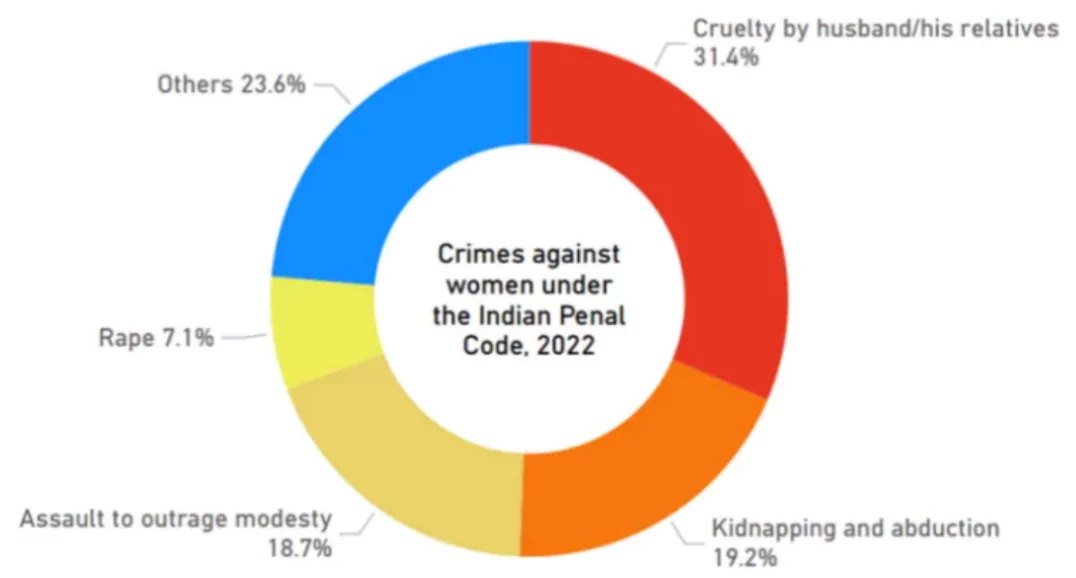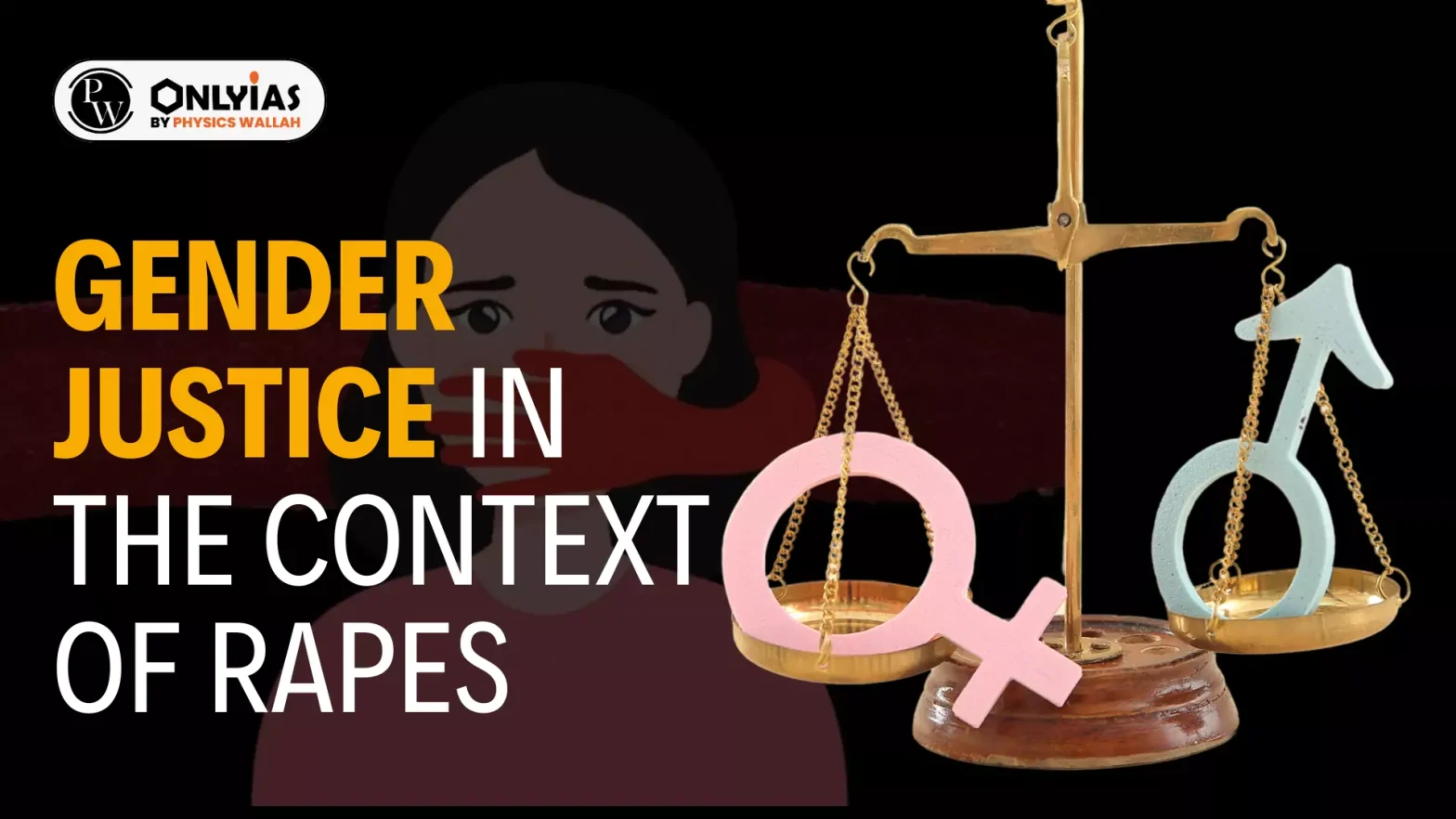The recent incident of sexual assault and Rape of a medical Intern in RG Kar Medical Hospital in Kolkata has again shed light on the precarious living conditions of women in India and their never ending struggle for gender Justice.
About Rape
- Definition: Rape is any non-consensual vaginal, anal or oral penetration of a sexual nature of the body of another person with any bodily part or object, including through the use of physical violence
- Legal Definition: Rape has been legally defined under Section 375 of Indian Penal Code 1860 as, a man is said to commit a rape when there has been sexual intercourse with a woman in any of the following circumstances,
- Against her will and consent
- When the consent is obtained but it should not be under the pretext of fear of death
- When the consent has been obtained fraudulently under the pretext of marraige
- When the consent is given by a person who is of unsound mind or intoxicated or unable to understand the nature of giving the consent.
 When a girl is under 16 years of age, with or without her consent.
When a girl is under 16 years of age, with or without her consent.
- Prevalence: As per the National Crime Records Bureau (NCRB) Data,
- Rapes: The Crime in India 2021 annual report, reports 31,677 rape cases, a rise from 2020 with 28,046 cases.
- Of these, 10 per cent were rapes of minors
- On an average India reported 90 cases per day in 2022.
- Conviction Rates: It ranged between 27%- 28% from 2018-2022
Enroll now for UPSC Online Course
Rape: A Tool for Violence against Women
- Power Crime: Rapes is widely seen as an accepted course of action to control a women with independent, modern thinking and lifestyle or just make a disagreeable women to agree as sexual assault is motivated by hostility, power and control.
- Example: In The 2012 Nirbhaya Case, The Rapist acknowledged to have committed the crime to teach the victim a lesson as she was being disagreeable.
Landmark Judgements and Changes in Rape Laws in India:
- Tukaram vs. State of Maharashtra (Mathura Case) 1983: The rape of a young tribal girl led to the first amendment of rape laws stipulating a minimum mandatory punishment of seven years for general rapes and 10 years for aggravated rapes
- Vishaka vs the State of Rajasthan (Bhanwari Devi Gang Rape Case): She was gang-raped by five men as she was preventing child marriage. in 1997 the Vishaka guidelines were formulated and made into the 2013 enactment ‘Sexual Harassment of Women at the Workplace (Prevention, Protection and Redressal) Act’
- Protection of Children from Sexual Offences (POCSO) Act 2012: It placed sexual violation of all children under 18, male or female, within its scope. It incorporated child-friendly procedures for reporting, investigation, recording of evidence, and trial.
- Failure to report the crime and even consensual sex with minors became an offence.
- Nirbhaya Case 2013: The rape laws were widened with a change in definition and minimum punishment increased of 20 years of imprisonment and death in extreme circumstances.
- In State v. Deepak, session court judges decided that being a sex worker does not mean accepting consent for sexual intercourse. The sex worker still possesses the right to be sought permission for such acts.
|
- Notion of Sexual Purity: Women bear the responsibility of her Family’s Honour by maintaining her sexual purity and any deviation on her part makes her liable for punishment.
- Example: Khap Panchayat’s orders of Revenge Rapes or mass Raping the women if she breaks the societal dictat.
- Patriarchal Attitudes on Women: The Patriarchal literature across all the societies and religions consider women’s primary role as child bearing. Thus, catering to male sexual entitlement becomes her purpose.
- Example: Manusmriti mentions women as one of the impure groups.
- In Conflict Situations: Rapes as a tool to shame and humiliate the other community in times of violence ie. ethnic (Manipur), communal (Bilkis Bano Rape Case), caste(Bhawari Devi Rape Case)
- Rape Culture: It is an environment where rapes and sexual violence is normalized and excused in the media and popular culture, perpetuated through the use of misogynistic language, the objectification of women’s bodies, and the glamorization of sexual violence
- Example: Victim Blaming (“She asked for it!”); Trivializing sexual assault (Boys will be boys or Men make Mistake); Sexually explicit jokes; Tolerance of sexual harassment; Publicly scrutinizing a victim’s dress, mental state, motives, and history
- Reinforce Repressive Gender and Caste Hierarchies: Women in general and Lower Caste women in particular are more vulnerable to rapes and sexual assault as they are otherwise treated as lesser species already. Such crimes are also a means to Reinforce Repressive Gender and Caste Hierarchies
- Example: In the Bhanwari Devi gang rape case of 1992, the trial court acquitted the accused on the grounds that an upper-caste man would not have touched a lower-caste woman.
- Rape Myths: No means yes; a lady never says yes; women like to be taken by force etc. are all myths perpetuated in common culture depriving women of their voice or agency to exercise her choice.
- Example: In the Movie ‘Pink’, A beautiful scene showed a woman’s ‘NO means NO’- there is no grey area here.
- Gender Inequality in Family: A familial structure where violence against women (mother, sister, daughter) is acceptable, often results in a dysfunctional violent household where this same anti women ideology is imparted on to the next generation.
- Pathological Obsession: The raping of minors, old aged women, women of unsound mind or even committing bestiality is nothing but a pathological obsession or addiction with sex.
- Technology Enabled: The increasing penetration of mobile phones and internet and lack of sexual education at homes and schools has led to young boys (minors) come across sexually explicit content (porn, bullying, abusive) in secrecy.
- Example: Three boys under eleven years of age were booked for gang raping a three year old girl in Bihar’s East Champaran District in 2021.
Check Out UPSC CSE Books From PW Store
Gender Justice
- Gender Justice is the principle of equality and equity for all people, irrespective of one’s gender, in all areas of life and is an intersectional approach focusing on the needs of the most discriminated and oppressed.
- The concept of gender justice is inclusive of transgender and nonbinary people.
- Constitutional Provision Promoting Gender Justice: Article 14 (Right to Equality), Article 15(1)( Right against Discrimination), Article 16 (Right to equal opportunity for all citizens in matters of public employment), Article 21 (Right to Life), Article 23 (Prohibits Trafficking in humans, begar, and other forms of forced labor), Article 42 (state’s responsibility to provide just and humane working conditions and maternity relief)
How the Principles of Gender Justice Can Combat Sexual Crimes?
- Equal rights: Everyone should have equal rights and be free from discrimination manifested in violence, abuse and unequal treatment at home, at work and wider communities.
- Everyone should be well versed about their gender specific rights and Gender Curriculum should be introduced in schools and colleges.
- Equal Access: Everyone should have equal access to resources and opportunities to learn, to earn and to lead, which will lead to safe places at work.
- Follow the Vishakaha guidelines stringently and also adopt some women specific initiatives like period leaves, separate resting rooms at workplace (RG Kar Hospital) etc.
- Representation: Equal representation of women as per their population will help shape the policies, structures and decisions affecting their lives and society as a whole. Women make up only 11 per cent of the police force.
- Example: Gender Budgeting; Gender Policing; Transgender Laws etc
- Safety: Everyone should have the right to bodily autonomy and safety with steps such as Gender Policing, Street Lighting, One Stop Centres for Crimes against women and Transgenders taken to make them feel secure. Workplaces should adopt a Zero Tolerance Policy.
- Freedom to Express Gender: Sexual Crimes are Gender Neutral affecting everyone, thus everyone should be free to express their gender in any way they choose, or to not express a gender at all without shame or fear.
- Accountability: There should be increased accountability for sexual and gender-based violence with proactive and sensitive and speedy policing and trails of such cases
Enroll now for UPSC Online Classes
Way Forward
- Adopt the RESPECT Framework: RESPECT women stands for (Relationship skills strengthening; Empowerment of women; Services ensured; Poverty reduced; Enabling environments (schools, work places, public spaces) created; Child and adolescent abuse prevented; and Transformed attitudes, beliefs and norms).
- Promoting Gender Sensitization: Conducting widespread gender sensitization programs to challenge and change the societal attitudes towards women and sexual violence.
-
- Example: National campaigns like Beti Bachao Beti Padhao should be expanded to include comprehensive gender sensitization at the community level.
- Expanding Victim Support Services: Establishing comprehensive support services for rape survivors, including legal aid, counseling, and rehabilitation.
- Example: The government could expand the scope of One Stop Centres to provide holistic support for survivors across the country.
- Implementing Mandatory Sex Education: Integrating comprehensive sex education into school curriculums to foster a culture of respect and consent from an early age.
- Example: States can implement an Adolescent Education Programme (AEP) more widely to educate young people about gender equality and sexual rights.
![]() 1 Oct 2024
1 Oct 2024

 When a girl is under 16 years of age, with or without her consent.
When a girl is under 16 years of age, with or without her consent.